Achieving equitable outcomes for ākonga Māori and Pacific students on their NCEA journey
Māori and Pacific peoples are disproportionately represented as under-served learners.
This paper aims to shine a light on Māori and Pacific students’ NCEA pathways using NCEA data (assessment standard entries and results) to trigger conversations about how best to address education inequities.
Download this paper as a PDF:
On this page
Data signposts
The following five data signposts highlight the current inequities in the system for Māori and Pacific students, compared with their NZ European and Asian counterparts. The inequities do not always manifest the same way for Māori as they do for Pacific students.
NZQA as the assessment agency and awarding body for NCEA and University Entrance tracks student achievement over the three years of senior secondary school (Years 11 to 13).
The 2017 Year 11 tracked student cohort is the dataset used in this paper1 for all the data signposts.
Signpost 1: Staying at school
Retention in schooling is the first data signpost that is an indicator of the current inequities in the senior secondary schooling system.
Why is staying in school important?
Completion of senior secondary education is associated with a range of economic and social benefits both in New Zealand and across the OECD.
Retention to senior secondary schooling is linked to higher levels of skills and knowledge required for participation in our increasingly knowledge-based society and the wider global community (OECD, 2017).
Māori students are less likely to remain in school until Year 13 than NZ European, Asian and Pacific students.
The graphic shows the proportion of students starting Year 11 in 2017 who left school in each of the following 3 years.
49% of Māori students who were in Year 11 in 2017 stayed in school until the end of Year 13, whereas 65% of Pacific students, 67% of NZ European students and 87% of Asian students did.
It also shows 15% of Māori students and 9% of Pacific students who were in Year 11 in 2017 left school by the end of that year, whereas 6% of NZ European students and 3% of Asian students did.
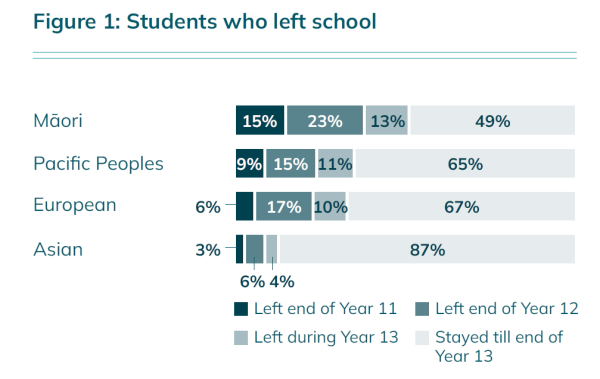
Signpost 2: Tracking achievement
NZQA tracks the highest NCEA qualification achieved by Year 11 students in their last three years of secondary schooling2.
Why is tracking achievement important?
While attainment of NCEA Level 3 or University Entrance may not be a pathway that all students aspire to, similar rates of achievement across ethnic groups would show the system is generally serving students fairly.
Current tracking shows that there are significant inequities in the highest level of secondary school achievement and illustrates that higher-level secondary school outcomes are disproportionately out of reach for Māori and Pacific students.
The graphic shows the highest NCEA qualification achievement for Māori, Pacific, NZ European and Asian students in their last three years of secondary schooling, based on the typical outcomes for 100 students.
Māori students are twice as likely to not achieve any NCEA qualification over the three years of senior secondary school as NZ European students.
Just over half of Asian students and just under half of NZ European students achieve NCEA Level 3 and University Entrance after three years of senior secondary, but less than a quarter of Māori and Pacific students do.
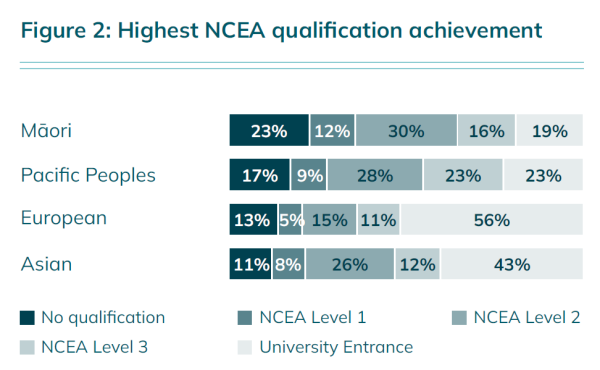
Signpost 3: Tracking credits assessed to achieve an NCEA
The third signpost points to the proportion of enrolled students who are not assessed3 in sufficient4 credits to achieve an NCEA or UE5.
Why is tracking credits important?
To be successful, students must have equitable access to both learning and assessment that opens up pathways from school into work and tertiary education and training.
The graphic shows that Māori students are less likely to be assessed in sufficient credits to achieve the level of NCEA (or UE) which would be typical in their year level.
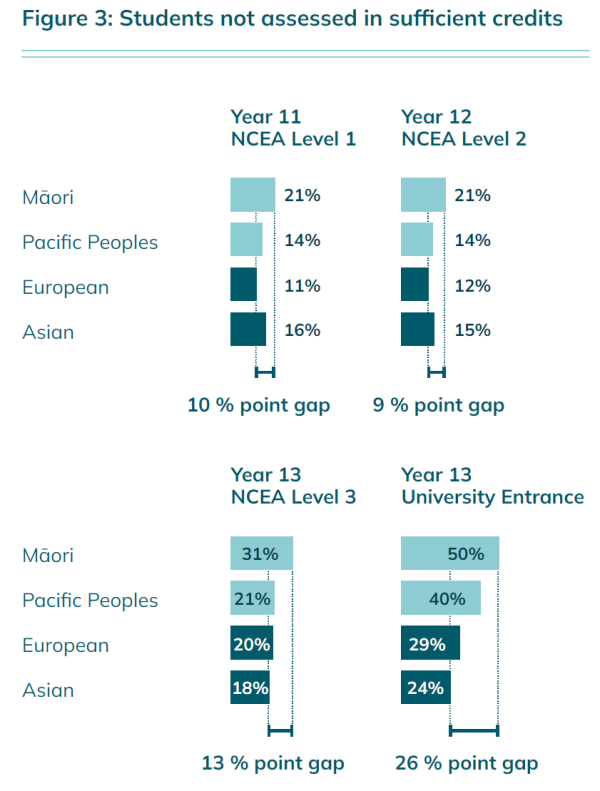
Signpost 4: Tracking course completions
Schools develop courses for their students and report their NCEA course information to NZQA. This includes what standards are in each course.
Why is tracking course completions important?
NZQA has determined through analysis of the course completion patterns of NCEA achievers that students need to be assessed6 in a minimum number of courses to support their NCEA achievement. For NCEA Level 1, the minimum is five courses, and for NCEA Levels 2 and 3, the minimum is four courses.
The chart below shows that Māori students – and, to a lesser degree, Pacific students – are less likely at every level to be engaged in sufficient courses to support the achievement of NCEA.
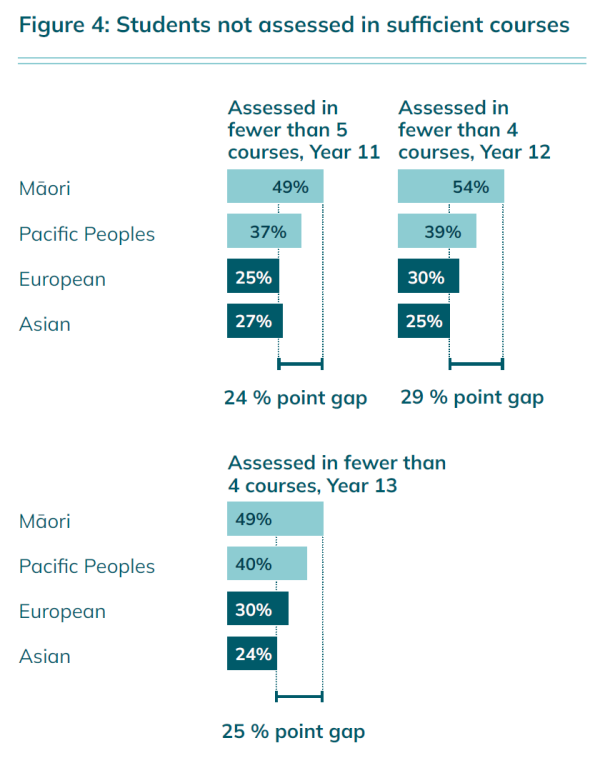
Signpost 5: Tracking the assessment programme mix
This signpost looks at the assessment programme mix of students.
Why is tracking the assessment mix important?
Assessment programmes can be made up of a mix of unit standards and achievement standards (internally and externally assessed). The choice of standards in years 11 – 13 can open up or limit pathways from school into work or tertiary education and training.
The chart shows the assessment programme mix of Level 2 and above standards for Year 12 students by ethnicity.
Māori and Pacific students have a larger proportion of unit standards in their assessment programmes – and a smaller proportion of externally assessed achievement standards – than NZ European and Asian students. This pattern is similar for Year 11 Level 1 and above standards, and Year 13 Level 3 and above standards.
While unit standards and achievement standards all contribute to the attainment of NCEA, unit standards do not contribute towards the 3 subjects required from the approved subject list for University Entrance.
By having an assessment programme with higher proportions of unit standards, Māori and Pacific students will generally find it more difficult to meet the threshold required to be awarded University Entrance.
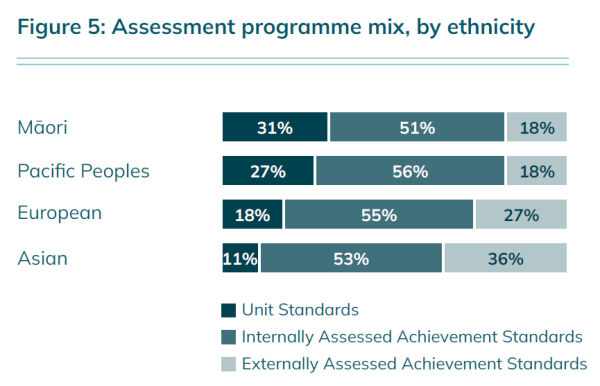
Conclusion
Across all five data signposts, there is evidence of inequity when comparing the outcomes for Māori and Pacific students to their NZ European counterparts.
A recently published paper Shifting the Dial: The Economic and Societal Impact of Removing Barriers for Underserved Learners in Aotearoa outlines recommendations for government, policy makers and education providers to address the inequities faced by under-served students.
Economic modelling by the New Zealand Institute of Economic Research outlined in the paper reveals lifting the educational outcomes of under-served learners to the national average would lead to $10.9 billion extra wages over a thirty-year period, adjusting for labour force participation.
To improve outcomes for Māori and Pacific students, effective systems and processes to track achievement and plan teaching, learning and assessment are essential.
Under-served students need:
- assessment in sufficient credits to meet the qualification requirements at each level
- engagement in at least the minimum requirements, including a sufficient number of courses, to support NCEA and UE attainment
- an assessment programme mix that keeps them engaged in learning and which opens up their pathways from school into work and tertiary
education and training.
References
Ministry of Education. (2021). Retention of ākonga, learners in senior secondary schools. Education Indicator report.
Up Education (2022). Shifting the Dial: The Economic and Societal Impact of Removing Barriers for Underserved Learners in Aotearoa.
Thought leadership papers (external link) — www.up.education
Resources to build cultural responsiveness
Tapasā is a tool that can be used to increase the capability of all teachers of Pacific learners. It was developed by the Ministry of Education through consultation with Pacific teachers, academics, experts, families and communities as part of the Pasifika Education Plan’s intention to realise the full potential of Pacific learners.
The Teaching Council led the implementation of Tapasā and created resources for teachers’ professional learning, including webinars and videos.
Tapasā: cultural competency framework for teachers of Pacific learners (external link) — Teaching council of Aotearoa NZ
Tātaiako helps teachers to understand and value what is important when taking a Māori world view in relation to teaching Māori learners. It is a framework that highlights five competencies that are essential values that need to be present when engaging Māori learners.
Tātaiako: cultural competencies for teachers of Māori learners (external link) — Teaching council of Aotearoa NZ
- Later cohorts have been impacted by COVID-19 and the various COVID-19 mitigations implemented for NCEAs and UE.
- Year 11 students who leave school prior to Year 13 are still included, and their attainment up to their departure from school is included.
- Assessed is defined as having a result of Not Achieved, Achieved, Merit or Excellence
- Sufficient is defined as 80 credits at Level 1, 60 credits at Levels 2 and 3, and 14 credits in each of 3 UE-approved subjects for UE.
- In the typical year pattern of Year 11 NCEA Level 1, Year 12 NCEA Level 2. Year 13 NCEA Level 3, Year 13 UE.
- Assessed is defined as being assessed in 14+ credits in a course. Schools decide courses and which standards are assessed within each course.

